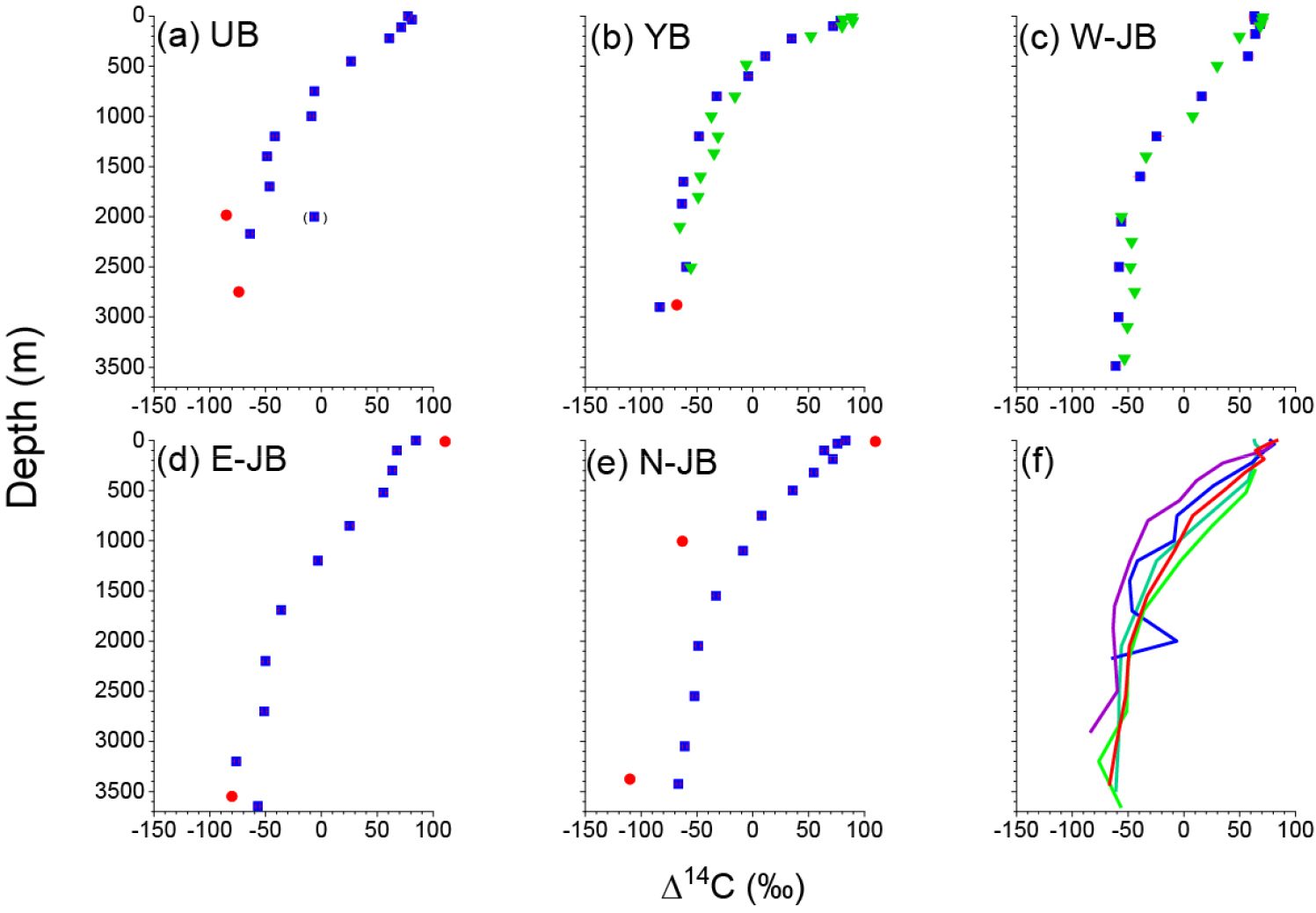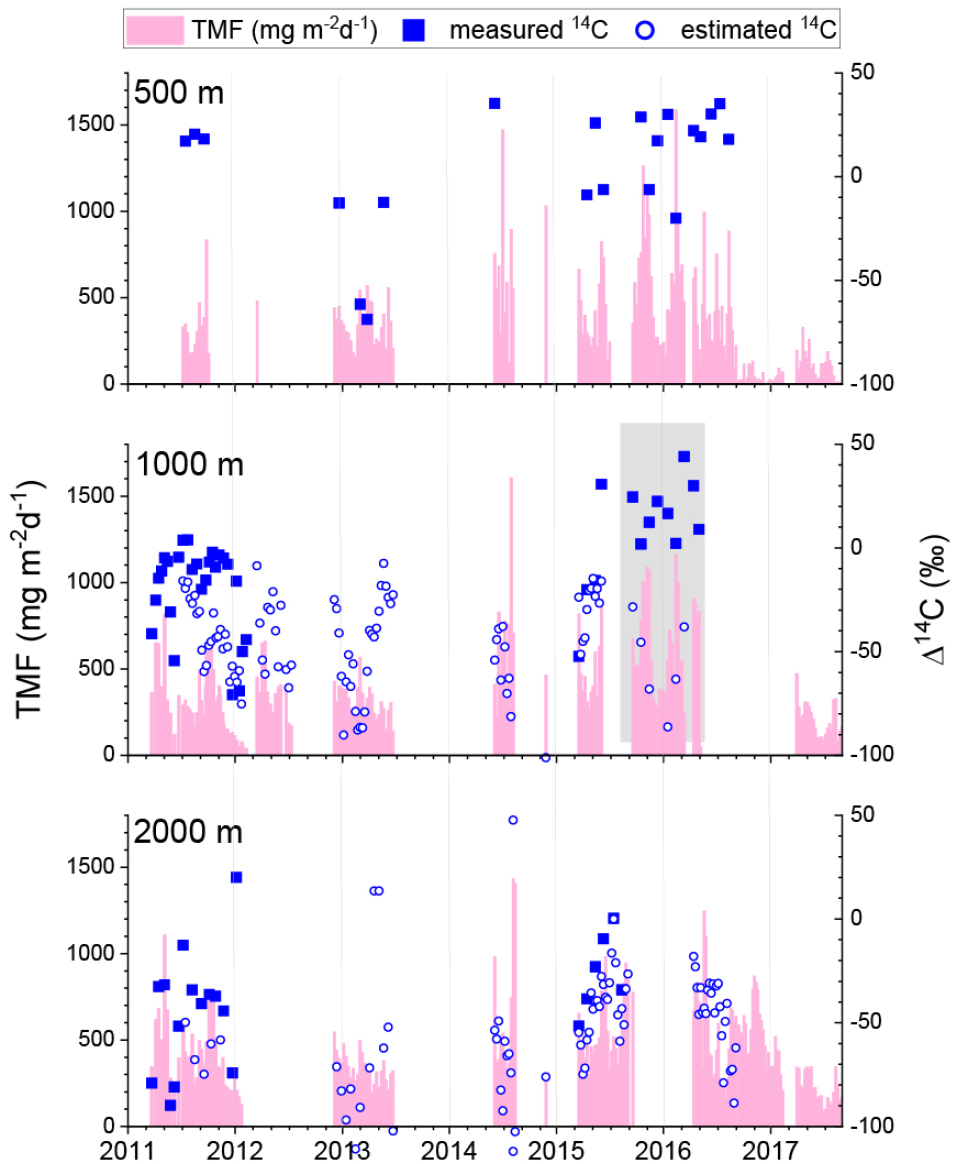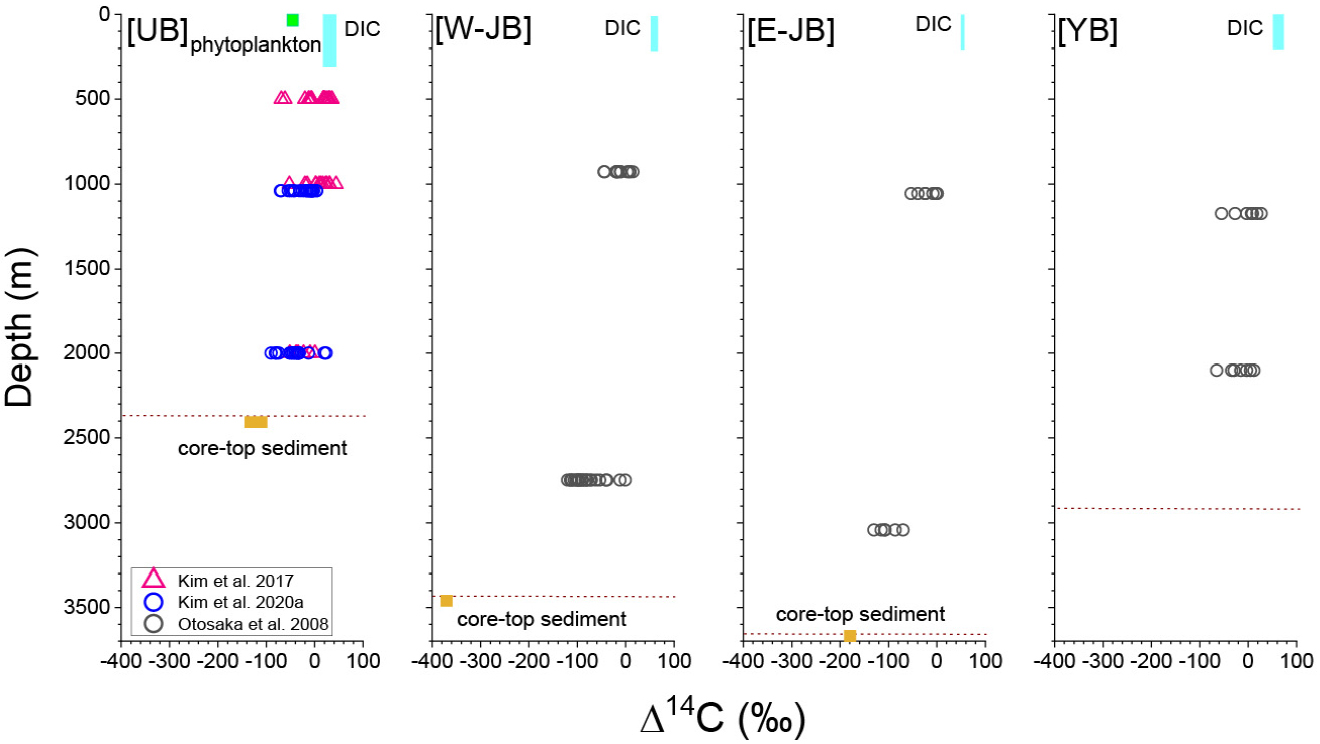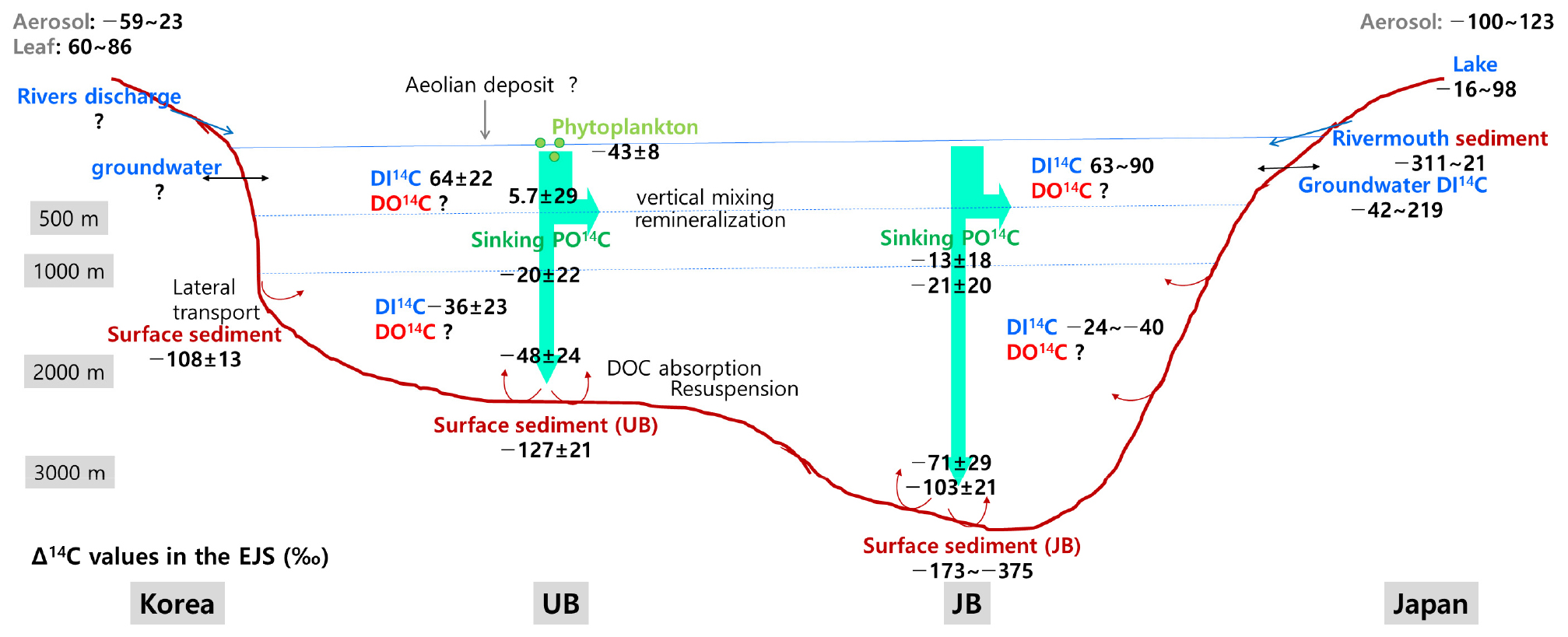1. 서 론
2. 14C 값의 활용과 동해 연구 현황
14C 분포와 분석법의 발달
용존무기탄소의 14C
침강입자유기탄소의 14C
3. 맺음말: 동해 14C 연구의 나아갈 방향 고찰
중장기적, 고해상도의 14C 값 확보
DOC를 비롯한 다양한 기원과 형태의 14C 값 확보
1. 서 론
탄소는 유기물을 구성하는 핵심 원소들 중 하나이자 대기 중 온실기체의 주요 구성 원소로, 탄소의 동위원소를 활용한 연구는 해양 탄소 순환을 이해하는 데 있어 중요한 정보를 제공한다. 탄소의 동위원소들 중, 방사성탄소동위원소(14C)는 성층권과 대류권 상부에서 우주선(cosmic ray)에 의해 생성된 열 중성자(thermal neutron)와 대기 중 14N이 핵반응을 일으켜 생성되며, 약 5730년의 반감기를 거쳐 자연 방사성 붕괴를 한다(Craig 1957). 대개 14C 값은 Δ14C나 Fm (Fraction modern)으로 표기되며, 이는 동위원소의 질량 차이로 인하여 자연적으로 발생하는 분별 작용(fractionation)의 영향을 제거한 값이기 때문에, 반감기에 따른 시간에 대한 정보를 제공하는 값으로 활용이 가능하다(Stuiver and Polach 1977). 해양에 존재하는 탄소는 그 기원에 따라 다양한 14C 값을 가지기 때문에, 이를 통해 탄소의 이동 및 퇴적 기작을 파악하고, 시공간적 변화와 성질을 이해할 수 있다(McNichol and Aluwihare 2007).
이렇듯 중요한 정보를 제공하는 화학적 추적자임에도 불구하고, 분석 방법과 비용 등의 제한으로 14C를 활용한 연구는 전 세계적으로 많지 않은 실정이다. 동해에서는 한국과 일본의 연구진들이 용존무기탄소(Dissolved Inorganic Carbon, DIC)와 입자상유기탄소(Particulate Organic Carbon, POC)에서 14C를 활용한 연구를 산발적으로 진행해 왔으나 분지 단위에서 제한적 개수의 시료를 분석한 연구가 대부분으로, 동해 전체를 이해하기에는 어려움이 있다. 본 논문에서는 그 동안 동해에서 진행되어 온 14C 연구 결과들을 소개하고, 향후 나아가야 할 방향에 관하여 설명하였다. 이를 통해 동해의 다양한 생지화학적 기작을 연구하는 국내 학자와 학생들이 14C 값을 연구에 접목시키고, 활용할 수 있기를 기대한다.
2. 14C 값의 활용과 동해 연구 현황
14C 분포와 분석법의 발달
대류권 상부에서 생성된 14C는 산소(O2)와 반응하여 14CO2를 형성한다. 표층 해수에 존재하는 14C는 주로 대기와 해양 사이의 물리적(예; 해수로의 용해), 생물학적(예; 식물플랑크톤의 광합성) 교환에 의한 값이며, 표층에 있던 수괴(water mass)가 해양 표층을 떠나면 14C의 공급원인 대기와의 탄소 교환은 단절된다. 반면 방사성 붕괴는 지속됨으로써, 수괴 중 14C의 농도를 통해 수괴의 나이나 이동 경로를 추적할 수 있다.
대기 중 14C의 농도는 자연적 생성 외에도 인간 활동에 의한 두 가지 특이한 분포(signal)를 보인다. 첫번째로, 20세기 중반 핵실험의 결과로 인해 대기 중 14C는 “bomb- spike”라고 불리는 모양을 보이며 그 농도가 급격히 증가하였다가, 1963년 핵실험을 금지하는 부분적 핵실험금지조약(Partial Test Ban Treaty, PTBT) 이후, 차츰 원래의 값으로 회복되고 있다(Fig. 1, Levin and Hesshaimer 2000; Schuur et al. 2016). 한편 1800년대 산업혁명 이후, 오랜 세월 동안 여러 차례의 반감기를 거쳐 14C가 모두 붕괴된(dead-carbon) 화석 연료의 연소로 배출되는 CO2로 인해 대기 중의 14C 값은 점점 줄어들고 있는데, 이를 “Suess Effect”라고 부른다(Graven 2015). 한 예로 1890년에서 1950년 사이 북미 태평양 연안에 서식하는 나무의 나이테에서 14C가 약 20‰ 감소하였고, 이 중 약 17‰이 화석 연료의 사용으로 인한 CO2것으로 추정되었다(Stuiver and Quay 1981). 대기 중 14C는 보다 안정적인 탄소 저장고인 해양으로 천천히 유입되어, 해양에서도 대기 중 14C 값과 비슷한 모양을 가진 완만한 그래프를 나타낸다(Fig. 1).

Fig. 1.
History of radiocarbon levels in atmospheric CO2 (red line, Hua et al. 2021) and coral records (Blue line, Wu et al. 2021). Symbols indicates measured 14C values in various samples in the East Sea and surface water DIC from nearby Pacific (Ge et al. 2022). EJS and UB indicates East (Japan) Sea and Ulleung Basin, respectively
1960년 Libby 박사가 14C 연대 측정기술을 개발한 공로로(Libby 1946, 1955) 노벨 화학상을 수상한 이후, 꾸준히 분석 기술이 발달되어 왔다. 초창기 14C 측정 방법은 이산화탄소로 변환한 시료의 14C가 15N으로 베타 붕괴하며 방출하는 전자를 측정하는 것으로, 1 g 이상의 탄소가 필요하고 수일에서 수주 이상의 긴 측정 시간이 소요되었다(Arnold and Libby 1949; Polach 1992). 예를 들어, DIC의 Δ14C (지금부터 DI14C로 기술)를 분석하기 위해서는 해수 약 200 L가 필요했다(Broecker et al. 1960). 이후 1977년 가속질량분석기(Accelerator Mass Spectrometer, AMS)를 분석에 활용하여 14C의 붕괴를 기다리지 않고도 시료에서 14C의 수를 계측할 수 있게 되면서 필요한 시료량(약 1 mg)과 측정 시간(1시간 미만)이 대폭 줄어들었다(Bennett et al. 1977; Nelson et al. 1977; Santos et al. 2007). 최근에는 MICADAS (Mini Carbon Dating Systems; https://www. ionplus.ch/micadas) AMS로 14C 분석의 새로운 국면을 맞이하고 있다(Welte et al. 2018; Blattmann et al. 2018a). 약 100 μg의 탄소로도 분석이 가능해졌으며, 원소 분석기(Elemental Analyzer) 등을 부착하여 이산화탄소 기체를 바로 이온화시키는 등 전처리와 분석 과정 또한 빠르고 간편해졌다(Synal et al. 2007; Wacker et al. 2010, 2013; McIntyre et al. 2017).
용존무기탄소의 14C
전 세계적으로 해양에는 약 39,000 Gt의 탄소가 저장되어 있고, 이 중 95% 정도가 DIC 형태로 존재한다(Key et al. 2004; Schuur et al. 2016). DI14C 값은 해양 수괴 순환이나 대기-해양 간의 탄소 교환 등 전지구적 탄소 순환에 있어 해양의 역할을 이해하는 데 유용한 정보를 제공하는 추적자로 다양하게 활용되고 있다(Graven 2015; Ge et al. 2016, 2022; Ding et al. 2018; Toggweiler et al. 2019).
동해에서는 1980년대 심층 해수 순환 연구의 일환으로 일본 연구진을 중심으로 DI14C 연구가 수행되어 왔다(Figs. 2 and 3). Gamo and Horibe (1983)는 동해 전역의 4개 정점에서 해양 표층과 심층수 1–3개 수심의 DI14C 값을 제시하였으며, 일본분지와 야마토분지를 중심으로 한 Kumamoto et al. (1998, 2008)의 연구, 그리고 Aramaki et al. (2007)의 연구가 수행되었다(Fig. 1, Table 1). 이후 Sim et al. (2014)이 1999년 여름 CREAMS (Circulation Research of the East Asian Marginal Seas) 조사에서 획득한 동해 전역의 5개 정점에서 DI14C 수직분포 자료를 얻었으며, 2001년 Aramaki et al. (2013)이 일본분지와 울릉분지를 지나는 7개 정점에서 DI14C 값을 분석하였다.

Fig. 2.
Map of the East Sea and sampling stations of sinking particles (reversed triangle; Stations EC1 and ES) and DIC (open circle = Sim et al. 2014, closed circle = part of stations from Gamo and Horibe 1983, Kumamoto et al. 1998, 2008, Aramaki et al. 2007, 2013). UB, YB, W-JB, E-JB, and N-JB indicates Ulleung Basin, Yamato Basin, Western-Japan Basin, Eastern-Japan Basin, and Northern Japan Basin respectively

Fig. 3.
Vertical profiles of DI14C in the major basins in the East Sea (a–e). DI14C in 1977/1979 (circle; Gamo and Horibe 1983), 1995 (reversed triangle; Kumamoto et al. 2008), and 1999 (square; Sim et al. 2014). DI14C in 1999 at all basins are shown in (f) with different colors from red to purple based on the deep water circulation (red: N-JB, green: W-JB, E-JB, blue: UB, and purple: YB). Redrawn from Sim et al. 2014. UB, YB, W-JB, E-JB, and N-JB indicates Ulleung Basin, Yamato Basin, Western-Japan Basin, Eastern-Japan Basin, and Northern Japan Basin respectively
Table 1.
Radiocarbon values measured in various ocean-related samples with region, year, sampling depth, and range of 14C with original references. Latitude and Longitude information for more than one station are not shown. UB, W-JB, E-JB, and YB indicates Ulleung Basin, Western-Japan Basin, Eastern-Japan Basin, and Yamato Basin respectively
| Samples | Region |
Lat. (°N) |
Long. (°E) | Year |
Δ14C (‰) |
Trap/water depth (m) | References |
| Aerosols | Anmyeondo | 2014–2016 | -59–23 | 46 m above sea level | Lee et al. 2020a | ||
| Hokkaido University, Japan | Mar.–Apr. 2001 | -100–123 | 35 m height | Kawamura et al. 2010 | |||
| Leaf | Gyeongju City, Korea | 2019 | 60–86 | ND | Lee et al. 2020b | ||
| Lake DIC | Lake Biwa, Japan | 1995, 1996 | -16–98 | Whole water column | Nakamura et al. 1997 | ||
| Phytoplankton | UB | 2011 | -43±8 (n = 4) | Surface | Kim et al. 2017 | ||
| Sinking POC | W-JB | 41.24 | 132.35 | 2000–2002 |
-13±18 -71±29 |
927 2746/3424 | Otosaka et al. 2008 |
| E-JB | 42.47 | 138.50 | 2000–2001 |
-21±20 -103±21 |
1057 3043/3642 | Otosaka et al. 2008 | |
| YB | 38.02 | 135.03 | 2000–2001 |
-3±28 -18±27 |
1175 2100/2900 | Otosaka et al. 2008 | |
| UB (ES) | 37.63 | 131.36 | 2011–2017 |
-5.7±29 -20±22 -48±24 |
300 1000 2000/2370 | Kim et al. 2017, 2020b | |
| Ocean Sediment | UB | 2011, 2014 | -127±21 (n = 3) | core-top | Kim et al. 2017, 2020b | ||
| UB shelf, slope, strait | 2011, 2014 | -108±13 (n = 4) | core-top | Kim et al. 2017, 2020b | |||
| W-JB | 2000/02 | -375±3 | core-top | Otosaka et al. 2008 | |||
| E-JB | 2000/02 | -173±4 | core-top | Otosaka et al. 2008 | |||
| YB | ND | ||||||
| River sediment | 6 major rivers in Japan | 2000/02 | -89±14 (n = 6) | River mouth | Otosaka et al. 2008, unpublished | ||
| DIC | East Sea | 1977, 1979 | -110–111 | Deep water | Gamo and Horibe 1983 | ||
| JB | 40 | 138 | Jun. 1987 | -66–37 | Whole water column | Tsunogai et al. 1993 | |
| JB, YB |
Nov.–Dec. 1995 | -49±4, -60±7 | Whole water column | Kumamoto et al. 1998 | |||
| JB | July 2002 | -65±5 | Whole water column | Aramaki et al. 2007 | |||
| JB, YB | 1995,2000 | -65–106 | Whole water column | Kumamoto et al. 2008 | |||
| JB, UB | April. 2001 | -63–100 | Whole water column | Aramaki et al. 2013 | |||
| East Sea | 1999 | -83–84 | Whole water column | Sim et al. 2014 | |||
| UB | 37 | 131 | 2011 | 30±12 (n = 7) | 0–300 m | Kim et al. 2017 | |
| Ground water | Northeast Japan | ND | -42–219 | 15–31 m | Takahashi et al. 2013 | ||
Sim et al. (2014)은 1999년 각 분지의 DI14C 수직분포를 이전의 연구 결과와 비교하였다(Fig. 3). 저자들은 1979년에 비해 1999년 일본분지 DI14C는 표층수(Surface Water)에서 약 50‰ 감소, 중앙수(Central Water)와 저층수(Bottom Water)에서는 80–100‰ 증가한 반면(Gamo and Horibe 1983; Kumamoto et al. 2008; Sim et al. 2014), 야마토분지의 표층수 DI14C는 1987년에 비해 약 10‰ 증가했고(Sim et al. 2014의 Fig. 4), 저층수에서는 거의 비슷함을 밝혔다(-68‰; Gamo and Horibe 1983, Sim et al. 2014). 울릉분지에서는 Sim et al. (2014)과 Aramaki et al. (2013)의 시료 채수 시기가 비슷하여 수직분포의 차이를 볼 수 없었다(Fig. 3). 나아가 Sim et al. (2014)은 일본분지, 울릉분지, 그리고 야마토분지로의 해수 순환에 따라 DI14C가 감소함을 제시하였다(Fig. 3f; Sim et al. 2014).

Fig. 4.
The total mass flux (TMF; bar graph) and ∆14C of POC at the three sampling depths (redrawn from Kim et al. 2017, 2020b). No bar indicates no data, and data from two sites (St. EC1 and ES) in 2011–2012 are shown together. Closed symbols are measured PO14C and open symbols are estimated PO14C values based on the equation in Fig. 6. Shaded area at 1000 m indicates where the measured and estimated PO14C values are not matched well.
DI14C 자료가 존재하는 20년(1979–1999년) 동안, Sim et al. (2014)은 동해 표층수의 DI14C가 연간 약 2‰씩 감소하는 양상을 보이며, 이는 핵실험 금지 이후 대기 중 14C의 감소(Fig. 1)를 반영한다고 해석하였다. 연간 인간 활동에 의한 CO2의 약 30–40%가 해양으로 흡수되는 것으로 알려져 있다(Tsunogai 2000; Gruber et al. 2009). Bomb-spike의 유입으로 인한 높은 DI14C 값은 태평양에서 최소 1000 m 수심까지 나타났고, 이를 활용하여 대기와 해양의 CO2 교환 양상 및 수온 약층 순환을 이해하는 연구가 진행되기도 하였다(Druffel et al. 2008; Key et al. 2004; Kumamoto et al. 2013). 동해에서도 지속적인 시계열 DI14C 분석을 통해 이산화탄소 흡수 능력을 규명할 수 있는 기초 자료를 제공할 수 있을 것으로 기대한다.
한편 같은 기간 동해 중앙수에서는 연간 약 3.3‰씩 DI14C 값이 증가한데 비해 심층수와 저층수의 DI14C는 증가하다가 1995년 이후 일정했는데, 저자들은 이를 표층에서 중앙수로의 표층수 공급은 강화되고, 저층수의 생성은 약화된 것으로 설명하였다(Kang et al. 2003; Aramaki et al. 2007; Kumamoto et al. 2008; Sim et al. 2014). 하지만 2000년대 이후, 해양 표층으로부터 용존산소(Dissolved Oxygen, DO) 공급이 동해 중앙수에서는 감소하고, 저층수에서는 증가하는 등의 새로운 관측 결과(Yoon et al. 2018)가 제시되었고, 이에 따라 동해 심층수 순환 규명에 도움을 줄 수 있는 화학적 추적자 연구가 필요한 실정이다. DI14C 값은 화학적 추적자로서 다양한 해역에서 수괴의 이동 및 혼합을 연구하는 데 사용되고 있지만(Broecker et al. 1960; Craig 1969), 동해의 심층 해수 순환 규모는 100년 정도로 대양에 비해 짧기 때문에 반감기가 5730년인 DI14C만을 활용하여 해수 순환 양상을 이해하기는 다소 난해할 수 있다. 반감기가 비교적 짧은 동위원소와 다양한 추적자(CFCs, 3H, 3He 등; Touratier et al. 2007)를 활용하고, 모델 연구를 접목하는 등(DeVries and Primeau 2011; Khatiwala et al. 2012)의 접근 또한 제안해 본다.
침강입자유기탄소의 14C
해수 표층의 유광대에서 식물플랑크톤의 일차 생산을 통해 DIC가 POC의 형태로 변환되고, 생물학적 탄소 펌프(Biological Carbon Pump, BCP) 기작을 통해 침강하는 탄소는 대기와의 교환이 어려운 심해나 해저면으로 이동, 격리된다(Volk and Hoffert 1985). 퇴적물 트랩(sediment trap)은 이렇게 침강하는 입자를 직접적으로 채취하는 도구로 널리 활용되고 있다(Honjo et al. 2008). 동해를 비롯한 세계 여러 해역에서 중장기적 퇴적물 트랩 연구가 진행되고 있지만 침강입자의 14C를 분석한 연구는 제한적으로 수행되어 왔다. 하지만 최근 해양 심층으로 침강하는 유기탄소가 시공간적으로 다양한 기원을 가지고 있다는 것이 밝혀지면서 14C를 활용한 연구의 중요성이 대두되고 있다(Druffel and Williams 1990; Eglinton et al. 2002; Hwang et al. 2010; Blattmann et al. 2018b; Kim et al. 2020a, 2020b).
동해 울릉분지에서는 1994–1996년, 그리고 2000년 초반 퇴적물 트랩 연구가 산발적으로 진행된 이후(Hong et al. 2008), 2011년부터 현재까지 약 10여 년 간 꾸준히 퇴적물 트랩을 계류 중이다(Fig. 1; Kim et al. 2017, 2020b). EC1 정점(37.33°N, 131.45°E, 수심 2300 m 트랩 1040 m, 2280 m)에서 2011–2012년, 그리고 ES 정점(ES (37.63°N, 131.36°E; 수심 2370 m, 트랩 1000 m, 2000 m)에서는 2011년 이후 침강입자 시료를 획득하고 있으며, 2017년까지의 자료를 바탕으로 중장기적 연속 시계열 변동을 해석하고 그중 일부 시료에서 PO14C 값을 분석하였다(Figs. 1 and 4; Kim et al. 2017, 2020a). 일본분지의 2개 정점과 야마토분지 1개 정점에서도 각각 2년(2000–2002년), 1년(2000–2001년) 동안 침강 입자의 양과 조성에 관한 연구가 진행되었으나, 그 이후로는 시료 채취가 지속되지 않았다(Fig. 1; Otosaka et al. 2004, 2008).
동해 전역에서 1000 m 수심의 POC 양은 일차 생산성의 2–5%에 달하며, 봄과 가을의 대번성 등 그 연간 변화를 반영하였다(Kim et al. 2017). 해수 표층에서 일차 생산을 통해 생성된 POC의 형성 기작 및 침강 속도를 고려한다면(Honjo et al. 1982; Berelson 2002), 침강 PO14C는 표층의 단성분(end-member; 표층수의 DI14C나 표층 부유입자, 또는 표층 식물플랑크톤의 PO14C 값)을 반영해야 한다. 2011년 8월 울릉분지 연구항해에서 획득한 표층수의 단성분은 이 해역의 복잡한 생지화학적 순환을 시사하였다(Kim et al. 2017). 표층수에서 식물플랑크톤 네트(직경 30 cm, 그물 크기 20 μm)로 획득한 식물플랑크톤의 ∆14C 값(-43±8‰)은 동일한 시기에 채취한 표층수의 DI14C 값(+30±12‰)보다 훨씬 낮았다(Fig. 5; Table 1). 반면, 1000 m 수심의 PO14C 값의 대부분은(-20±22‰) 표층 식물플랑크톤의 PO14C보다 높았다. 이는 일차 생산으로 만들어진 PO14C 외에도 오래된 PO14C가 표층수에 공급되었음을 뜻하는데, 저자들은 그 잠재적인 기원을 하천의 부유 입자 또는 대기 중에서 공급되는 POC 등으로 추정했다(Kawamura et al. 2010; Kim et al. 2017).

Fig. 5.
Vertical change of ∆14C of POC in the major basins in the East Sea (redrawn from Otosaka et al. 2008). Horizontal dotted lines indicate water depth. Data is from Kim et al. (2017, 2020b) for UB and Otosaka et al. (2008) for other basins. UB, W-JB, E-JB, and YB indicates Ulleung Basin, Western-Japan Basin, Eastern-Japan Basin, and Yamato Basin respectively
깊은 수심(> 2000 m)에서 PO14C 값은 울릉분지, 일본분지의 서쪽과 동쪽, 그리고 야마토분지에서 각각 평균 -48‰, -71‰, -103‰, 그리고 -18‰였는데, 저자들은 이러한 분지 별 차이는 표층 퇴적물의 연대 차이에서 기인하는 것으로 해석하였다(Fig. 5; Otosaka et al. 2008, Kim et al. 2017). 오래된 POC는 비생물학적 입자(Lithogenic material, LM)와 결합되어 재부유나 수평적 이동 과정을 통해 해양 저층에 존재하는 것으로 알려져 있다(Taylor and McLennan 1985; Hwang et al. 2010; Kim et al. 2020a, 2020b). 동해는 깊은 수심의 분지가 있는 해역임에도 불구하고, 침강입자 중 비생물학적 입자의 비율이 울릉분지의 1000 m와 2300 m에서 각각 34%, 50%, 일본분지 서쪽의 927 m, 2746 m에서 34%, 46%, 일본분지 동쪽의 1057 m, 3043 m에서 25%, 43%, 그리고 야마토분지의 1175 m, 2100 m 수심에서 33%, 44% 로, 전지구 평균(약 25%)보다 높았다(Otosaka et al. 2008; Kim et al. 2017, 2020b).
이전에 Hwang et al. (2010)은 침강 입자의 PO14C 값이 해양 저층 퇴적물을 대표할 수 있는 알루미늄 농도(Al%)와 음의 상관관계를 보임을 제시하였는데, 이 관계는 오래된 POC의 주요 기원이 재부유 퇴적물과 관련이 있음을 의미한다(Sherrell et al. 1998; Honda et al. 2000; Hwang et al. 2010; Kim et al. 2020a). 최근 Kim et al. (2020a)은 침강입자 중 비생물기원 입자와 POC의 비율(=LM/POC)을 활용하여, 해역별로 LM/POC와 입자유기탄소의 PO14C가 직선형의 상관 관계를 보임을 확인하였다. LM/POC 값이 있다면, 관계식을 통해 PO14C 값의 대략적 유추가 가능하다. 동해의 경우, 심층(> 500 m)에서 LM/POC와 침강입자의 PO14C가 상관 관계(y = -8.38x + 13.5, R2 = 0.55)를 보였다(Fig. 6). LM/POC 값과 식을 통해 추정한 PO14C 값을 실제 분석한 PO14C 값과 함께 나타내 본 결과, 대체로 실제 PO14C와 유사했다(Fig. 4). 이를 통해 입자의 양이 많은 대륙 주변부나 혼탁층 뿐만 아니라 동해와 같은 깊은 분지가 있는 해역에서도 퇴적물의 재부유와 이들의 수평 이동이 탄소 순환의 중요한 기작임이 밝혀졌다(Bauer and Druffel 1998; Dunne et al. 2007; Gardner et al. 2018; Kim et al. 2020a, 2020b). 나아가 LM/POC은 14C에 비해 측정이 용이하고, 수층에서 쉽게 분해되거나 그 값이 변하지 않기 때문에, 시료의 14C의 측정이 불가능할 경우 침강입자 시료의 LM/POC비를 통해 재부유 퇴적물의 유입 정도를 대략적으로 파악할 수 있을 것으로 기대한다(Kim et al. 2015, 2020b).

Fig. 6.
Δ14C values (‰) against the ratio of the content of lithogenic material to the POC (LM/POC) of sinking particles (redrawn from Kim et al. 2020a). Data from Kim et al. (2017, 2020b) for the UB (square), Otosaka et al. (2008) for western JB (diamond), eastern JB (triangle), and YB (circle). The cloud denotes the linear fit of the sinking particles at 500 m and at 1000–3000 m depths. UB, W-JB, E-JB, and YB indicates Ulleung Basin, Western-Japan Basin, Eastern-Japan Basin, and Yamato Basin respectively
하지만, 연간 동해 심층 침강 입자의 PO14C 값은 넓은 범위를 보이고 있어, 트랩 계류 지점에서 재부유된 퇴적물의 유입뿐만 아니라 주변부에서 재부유되어 수평 이동한 해저 퇴적물로부터의 기원, 육상과 대기로부터의 유입, 용존유기탄소의 흡착 등 다양한 기원을 가진 유기 탄소의 영향을 받은 것으로 보인다(Fig. 5; Druffel and Williams 1990; Eglinton et al. 2002; Goni et al. 2005; Blattmann et al. 2018b). 한편 상층(300–500 m)의 LM/POC와 PO14C 값은 심층의 값과 같은 관계식을 따르지 않았는데(Fig. 6), 이는 상층 PO14C도 재부유 퇴적물 외의 오래된 유기탄소의 영향을 받기 때문인 것으로 보인다. 상층의 PO14C나 LM 값은 MERRA (Meteorological and Aerosol Reanalysis)로 추정한 대기 중 분진(dust) 값과도 일치하지 않아 대기로부터의 유입 외에도 다양한 기원의 유기탄소가 유입됨을 뜻한다(Otosaka et al. 2008; Kim et al. 2017, 2020a). 이러한 각각의 기원지로부터의 유기탄소 유입량과 그 변동을 규명하기 위해서는 기원지의 14C 단성분을 보다 정확히 파악하는 것이 필수적이다.
3. 맺음말: 동해 14C 연구의 나아갈 방향 고찰
14C를 활용한 연구는 해양에서의 탄소 순환과 역학을 이해하는 데 있어 중요한 정보를 제공하지만, 비용과 분석의 어려움으로 비교적 단발적으로 수행되어 왔다. 최근 분석 기술의 발달은 14C 데이터 획득에 긍정적 변화를 주고 있으며(Fagault et al. 2019), 이에 따른 14C의 활용법과 전망에 대한 고찰도 꾸준히 진행되고 있다(Hwang 2012; Alves et al. 2018; Skinner and Bard 2022). 하지만 아직까지 대부분의 국내 14C 결과는 국외 기관(스위스 연방공과대학교, 미국 우즈홀 해양연구소, 뉴질랜드 GNS SCIENCE 등)에 분석을 의뢰하여 얻은 값이며, 시료 1개 당 80–90만원 가량의 분석 비용이 발생하고 있다. 따라서, 궁극적으로는 국내 해양학 및 지구과학 연구를 위한 MICADAS 장비 구축이 필요할 것이다. 나아가 자연상태에서 14C의 농도는 14C는 전체 탄소의 약 1.2 × 10-10% 정도로 굉장히 낮기 때문에, 시료의 채취에서 보관, 분석에 이르는 일련의 과정에서 오염에 각별히 주의가 필요하므로, 분석 전문 인력의 양성도 필요하다.
동해는 해양 연구 목적에 대한 접근성이 좋을 뿐 아니라, “소형 해양(miniature ocean)”으로 불릴 만큼 자체적인 심층 순환을 비롯한 다양한 해양학적 기작이 발생하는 해역으로, 대기에서 해양으로의 이산화탄소 유입, 해양의 탄소 저장 능력에 관한 연구를 하기에 적합하다. 하지만 동해 탄소 순환을 이해하는데 있어 탄소의 다양한 기원과 이동량, 이동 기작, 기후 변화에 따른 시공간적 변동 등은 아직 해결해야 할 문제로 남아있다(Fig. 7). 본 리뷰에서는 14C를 활용한 동해 연구의 방향으로 아래의 두 가지를 제시하고자 한다. 이로써 기후 변화에 따른 동해의 역할을 규명하고, 미래 탄소 순환을 예측하는 데 있어 보다 정확하고 다양한 정보를 제공할 수 있을 것이다.

Fig. 7.
Schematic of the Δ14C values (‰) of various samples in the East Sea (redrawn from Kim et al. unpublished). Data and related references are in Table 1 and main text. ∆14C of DIC is collected in 1999 (Sim et al. 2014)
중장기적, 고해상도의 14C 값 확보
DI14C는 시간에 따른 인간 활동에 의한 대기 중 탄소의 흡수 정도를 파악할 수 있는 좋은 추적자이기에, 장기 데이터 확보가 필요하다. 전 세계적으로 대양에서는 1970년대 GEOSECS (Geochemical Ocean Sections Study)를 통해 약 300개 정점에서 DI14C를 비롯한 해양 화학 인자를 분석하였으며, 1990년대에는 WOCE (World Ocean Circulation Experiment), OACES (Ocean Atmosphere Carbon Exchange Study)등의 프로그램이 진행되었다(Key 1996; Dutta et al. 2010). 이후, GLODAP (Global Ocean Data Analysis Project)을 통해 DI14C를 포함한 해양 자료를 공유할 수 있게 되었다(Key et al. 2004; Lauvset et al. 2021; Ge et al. 2022; https://www.glodap.info/index.php/merged-and- adjusted-data-product-v22021/). 한편 2014년 Sim et al. (2014)이 1999년 동해 전역의 DI14C 값 발표 이후, 동해에서 DIC 시료 채취와 농도 측정은 산발적으로 이루어졌으나(Na et al. 2022), DI14C 결과는 논문으로 보고된 바가 없다. 2000년대를 지나며 대기 중 14C의 값이 해양 산호 시료에서 측정한 14C의 값보다 작아지는 변환점이 시작되었으며(Fig. 1), 이에 따른 해양 14C의 장기적인 변화를 파악하는 것은 해양의 탄소 저장고로서의 역할을 규명하는 데 있어 중요한 정보를 제공할 것이다. 다양한 화학적 추적자(CFCs, 3H, 3He 등; Tsunogai et al. 2003), DO 등과 저층수 생성의 장기 변동성(Yoon et al. 2018; Li et al. 2022)을 DI14C 값과 연계하여 해석한다면 동해 심층 해수 순환에 중요한 정보를 제공할 수 있을 것이다.
침강입자 시료는 2011년 이후 300 (500) m, 1000 m, 2000 m 수심에서 꾸준히 채취되어 오고 있으며(Kim et al. 2017, 2020a), 이를 통해 기후 변화에 따른 동해 BCP의 중장기적, 고해상도 변동을 규명하고 다양한 나이와 기원의 유기 탄소의 해양으로의 유입을 파악할 수 있을 것이다. 특히 침강입자 시료는 대부분 양이 굉장히 적기 때문에 동해 울릉분지는 북극해 캐나다 분지(Canada Basin; Hwang et al. 2015), 서남극 아문젠해(Kim et al. 2015), 태평양의 정점 M (Hwang et al. 2010), 북서대서양(Hwang et al. 2017) 등과 함께 장기 침강입자 시료의 14C 값이 존재하는 몇 안 되는 정점 중 한 곳이다. 따라서, 동해에서의 침강입자에 대한 연구는 향후 전지구적 BCP 기작을 규명하는 데 있어 핵심적인 중장기적 연구 정점으로 활용할 수 있을 것으로 기대한다.
한편 동해에서는 비교적 시료의 양이 제한적이지 않은 표층 퇴적물의 14C 값도 거의 없는 실정이다(Kim et al. 2017). 인근의 동중국해에서 Bao et al. (2016)이 표층 퇴적물 시료 360여 개의 14C 값을 제시하고(Bao et al. 2016의 Fig. 1), 이 중 16개 시료를 입자의 크기(< 20, 20–32, 32–63 μm)별로 분별하여 14C 값을 분석하는 등(Bao et al. 2018a, 2018b, 2018c, 2019a, 2019b) 다양한 고찰을 해 온 것은 향후 동해에서 해양 표층 퇴적물의 14C를 활용한 탄소 순환 연구를 수행하는 데 있어 좋은 예가 될 것이다.
DOC를 비롯한 다양한 기원과 형태의 14C 값 확보
울릉분지 침강입자의 PO14C연구 결과, 수층의 PO14C가 다양한 기원을 가지고 있음이 밝혀졌다(Kim et al. 2017; Otosaka et al. 2008). 동해로 유입될 수 있는 POC는 크게 대기로부터의 유입, 해양저 퇴적물에서의 재부유 및 수평이동, 강이나 지하수로부터의 유입, 그리고 대마 난류를 통한 유입 등이 있는데(Kim et al. 2017, 2020b), 각각의 기원으로부터의 POC유입 기작을 규명하고, 나아가 이를 정량화하기 위해서는, POC 기원지의 14C 단성분을 보다 정확히 파악해야 한다(Fig. 7).
안면도(해면 고도 46 m)와 훗카이도 대학(35 m 높이)에서 대기 중 에어로졸의 14C를 분석한 값은 각각 약 -59–23‰과 -100–123‰로, 다양한 범위를 보여, 오래된 탄소가 대기로부터의 유입될 수 있는 가능성을 시사하였다(Kawamura et al. 2010; Lee et al. 2020a). 경주에서 채취한 나뭇잎의 14C는 60–86‰로 대기 중 14C 값과 유사했는데, 이는 광합성을 하는 독립영양생물의 14C가 대기 중 14CO2 값을 갖는 특성을 잘 반영하고 있다(Figs. 1 and 7; Lee et al. 2020b). 하지만 강 등을 통해 해양으로 유입되는 육상 기원 유기 탄소는 대기로부터의 탄소 고정 이후 어느 정도 시간을 거쳤기 때문에, 실제 육상 기원 유기물의 14C의 농도는 이보다 낮을 것이다(Tao et al. 2015). 실제로 황하나 양쯔강 등 거대한 강의 영향을 받는 해역에서 오래된 유기탄소의 함량이 높게 관측되었다(Bao et al. 2016; Yu et al. 2019). 한국의 강하구에서 14C 값의 연구 결과는 아직 없으나, 일본 북부의 Ishikari, Yoneshiro 등 강하구 퇴적물의 14C 값은 각각 -311‰, 21‰로, 지역에 따른 차이가 있지만 평균 –89±14‰ (n = 6; Otosaka et al. 2008)로 낮은 14C 값을 보여 동해로 유입되는 하구역별 14C 값과 해양으로의 유입량과 중요성 등을 규명하는 연구가 필요함을 시사하였다.
한편 동해에서 DOC의 14C 값은 아직까지 출판된 자료가 부재한 만큼 값의 분석이 필요하다(Fig. 7). 심해에 서식하는 독립, 종속 영양 생물들은 동해 탄소 순환에 영향을 미칠 것이기 때문에, 탄소 순환에 있어 미생물 군집의 역할과 대사 과정을 DO14C 연구를 통해 정량화할 수 있을 것으로 기대한다(Herndl and Reinthaler 2013). 남중국해의 경우, 대만에서 14C 값이 굉장히 낮은 petrogenic OC (kerogen 등)가 유입되어 해양 유기탄소 값에 영향을 미치는 것이 밝혀졌는데(Bao et al. 2016; Blattmann et al. 2019), 동해나 제주도 연안의 지하 용출수의 DO14C 값 등 해양으로 유입되는 다양한 탄소 기원의 단성분을 이해하는 연구 또한 필요할 것이다. 일본 북부지역 3개 정점에서 깊이에 따른 지하수의 DI14C 값을 분석한 결과 상층 15–31 m에서 -42–219‰로 지하수의 용출 또한 오래된 유기탄소의 기원이 될 수도 있음을 시사하였다(Fig. 7, Table 1; Takahashi et al. 2013). 따라서, 동해의 다양한 탄소 저장고의 14C 값을 통해 저장고 간의 상호작용 역학, 탄소의 체류 시간 및 수송 경로, 기원 등을 보다 정확히 추정하고 동해 내부 14C 값의 시공간적 변화를 파악할 수 있을 것으로 기대한다.
14C 값은 붕괴 상수를 기반으로 탄소의 나이에 관한 정보만을 제공하지만, 해양 시료의 14C는 다양한 물리적, 생지화학적 기작을 겪은 여러 기원의 14C 값을 통합하여 나타낸다. 분석법의 발달로 분석에 필요한 탄소량이 점차 줄어들고 있으며, 따라서 전체 입자의 14C를 분석하는 방법에서 나아가 특정 화합물을 분석하거나(Eglinton et al. 1997; Gies et al. 2021), 시료를 밀도나 입자의 크기(Wakeham et al. 2009; Bao et al. 2019a)에 따라 또는 Ramped Pyrolysis (RP) 등 열처리(Subt et al. 2016; Hemingway et al. 2019)를 통해 세분하여 14C를 분석함으로써 다양한 해양 기작에 관한 이해에 14C를 활용할 수 있을 것이다. 이 리뷰 논문을 통하여 국내 연구자와 학생들이 14C를 활용한 동해 연구에 보다 관심을 가지고 활약하기를 기대한다.




